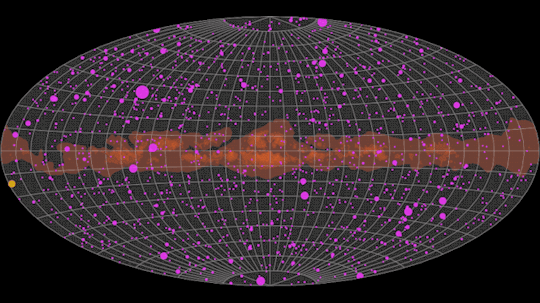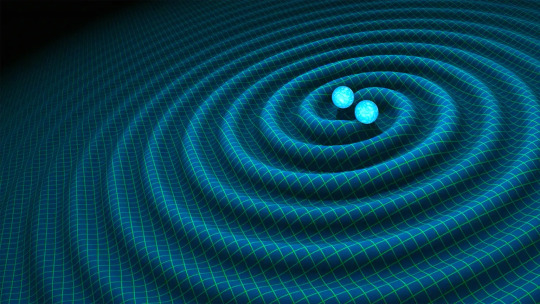#fermi
Text






some possible explanations for the fermi paradox, according to wikipedia (inspired by this vid)
downloadable as a zine on my etsy!
#zine#wikipedia#etsy#art#poem#poetry#fermi#fermi paradox#physics#aliens#alien#collage#mixed media#mixed media art#collage art#mine
143 notes
·
View notes
Text
What is the Fermi paradox?
Here's a fun analogy:
You walk up to an ocean with a bucket and fill this with water. After looking into the bucket you see there's no fish. Can you then conclude that there are no fish in the ocean?
This is something that crosses my mind often when I think about extraterrestrial life. Can we really make the conclusion that we are alone in the universe when we can't even see all of it? The universe as we know it has trillions and trillions of other habitable planets so it would be absurd to think that there is absolutely no other life apart from right here on our little planet. But where is it?
That's the Fermi paradox. Sure, we've concluded that the possibility of other planets with life isn't crazy to think about, it's pretty high, but then how come we don't know anything about it at all?
It's often assumed that other life out there would have to be a much higher, more advanced form of civilization. Afterall, other planets and suns have existed for billions of years longer than Earth has, so even if we haven't found them yet, how come there has been absolutely no sign of anything bigger than us? The explanation would be that there is no civilization that's that much bigger and further in their technology than we are. But if there are so many more planets and there have been for so long that have the same conditions as Earth, there has to be something stopping that from happening. The Great Filter.
But what if there is super-intelligent life out there and they have no reason to come anywhere near us or show any signs? There are lots and lots more possibilities we have thought about for this one. It could be that that life has already visited our planet before we were here or that there's been a lot of signs out there, but we don't have the technology to pick it up and we're listening for the wrong things or another popular one, we have already been in contact with a higher civilization but the government is hiding it from us.
Whatever you choose to believe, I'll leave you with my favorite quote on this topic. "Two possibilities exist: Either we are alone in the Universe or we are not. Both are equally terrifying" - Arthur C. Clarke
#study#alien#aliens#theory#galaxy#learning#funfact#fun facts#fermi#fermi paradox#the great filter#milky way#universe#thoughts#spilled thoughts#thinking#existence#deep thoughts#education#educational#my thoughts
119 notes
·
View notes
Text
29 notes
·
View notes
Text

A very last-minute convention badge for my good friend, Fermi!
[If you want a commission, check out this link: https://www.kalzeria.com/art-commissions/ ]
21 notes
·
View notes
Text

I am so back gsjsgjgsjfsjfs
#james webb space telescope#jwst#fermi gamma-ray space telescope#fermi#personification#gijinka#my art#artists on tumblr#nasa#sketch
2 notes
·
View notes
Text

College was the fulfillment of my dreams: I found teachers who not only understood science, but who were actually able to explain it. I was lucky enough to attend one of the great institutions of learning of the time, the University of Chicago. I was a physics student in a department orbiting around Enrico Fermi; I discovered what true mathematical elegance is from Subrahmanyan Chandrasekhar; I was given the chance to talk chemistry with Harold Urey; over summers I was apprenticed in biology to H. J. Muller at Indiana University; and I learned planetary astronomy from its only full-time practitioner at the time, G. P. Kuiper.
From “The Demon-Haunted World: Science as a Candle in the Dark” by Carl Sagan, 1995.
This is fucking insane, y’all. All these people have important scientific things named after them, Nobel prizes, or both.
Fermi worked at Los Alamos and created the first nuclear reactor, Chandrasekhar revolutionized our understanding of the relationship between stellar mass and lifespan, Urey is one-half of the duo with the iconic experiment behind our current understanding of the origins of life on planet Earth, Muller (despite being a eugenicist, ew,) discovered that X-rays cause damage to DNA and thus mutations, and Kuiper was (one of) the first planetary scientists.
I talk about the ideas of these guys in my classes every year! And all of this was in the previous century! Hell, Hubble only proved conclusively that there are other galaxies outside the Milky Way in Ninteen-twenty-four! Less than a hundred years ago.
What else will we learn in the next hundred????
#i love science#cool science stuff#teaching#carl sagan#fermi#chandrasekhar#urey#kuller#kuiper#astronomy#nuclear physics#genetics#chemistry#science#discovery#the demon haunted world
6 notes
·
View notes
Photo

Fermi captures dynamic gamma-ray sky in new animation Cosmic fireworks, invisible to our eyes, fill the night sky. We can get a glimpse of this elusive light show thanks to the Large Area Telescope (LAT) aboard NASA’s Fermi Gamma-ray Space Telescope, which observes the sky in gamma rays, the highest-energy form of light. This animation shows the gamma-ray sky’s frenzied activity during a year of observations from February 2022 to February 2023. The pulsing circles represent just a subset of more than 1,500 light curves – records of how sources change in brightness over time – collected by the LAT over nearly 15 years in space. Thanks to the work of an international team of astronomers, this data is now publicly available in a continually updated interactive library. A paper about the repository was published March 15, 2023, in The Astrophysical Journal Supplement Series. “We were inspired to put this database together by astronomers who study galaxies and wanted to compare visible and gamma-ray light curves over long time scales,” said Daniel Kocevski, a repository co-author and an astrophysicist at NASA’s Marshall Space Flight Center in Huntsville, Alabama. “We were getting requests to process one object at a time. Now the scientific community has access to all the analyzed data for the whole catalog.” Over 90% of the sources in the dataset are blazars, central regions of galaxies hosting active supermassive black holes that produce powerful particle jets pointed almost directly at Earth. Ground-based observatories, like the National Science Foundation’s IceCube Neutrino Observatory in Antarctica, can sometimes detect high-energy particles produced in these jets. Blazars are important sources for multimessenger astronomy, where scientists use combinations of light, particles, and space-time ripples to study the cosmos. “In 2018, astronomers announced a candidate joint detection of gamma rays and a high-energy particle called a neutrino from a blazar for the first time, thanks to Fermi LAT and IceCube,” said co-author Michela Negro, an astrophysicist at the University of Maryland, Baltimore County, and NASA’s Goddard Space Flight Center in Greenbelt, Maryland. “Having the historical light curve database could lead to new multimessenger insights into past events.” In the animation, each frame represents three days of observations. Each object's magenta circle grows as it brightens and shrinks as it dims. Some objects fluctuate throughout the entire year. The reddish orange band running across the middle of the sky is the central plane of our Milky Way galaxy, a consistent gamma-ray producer. Lighter colors there indicate a brighter glow. The yellow circle shows the Sun’s apparent annual trajectory across the sky. Processing the full catalog required about three months, or more than 400 computer years of processing time distributed over 1,000 nodes on a computer cluster located at the SLAC National Accelerator Laboratory in Menlo Park, California. The LAT, Fermi’s primary instrument, scans the entire sky every three hours. It detects gamma rays with energies ranging from 20 million to over 300 billion electron volts. For comparison, the energy of visible light mostly falls between 2 to 3 electron volts. The Fermi Gamma-ray Space Telescope is an astrophysics and particle physics partnership managed by Goddard. Fermi was developed in collaboration with the U.S. Department of Energy, with important contributions from academic institutions and partners in France, Germany, Italy, Japan, Sweden, and the United States. IMAGE....Watch a cosmic gamma-ray fireworks show in this animation using just a year of data from the Large Area Telescope (LAT) aboard NASA’s Fermi Gamma-ray Space Telescope. Each object’s magenta circle grows as it brightens and shrinks as it dims. The yellow circle represents the Sun following its apparent annual path across the sky. The animation shows a subset of the LAT gamma-ray records now available for more than 1,500 objects in a new, continually updated repository. Over 90% of these sources are a type of galaxy called a blazar, powered by the activity of a supermassive black hole. Credits: NASA's Marshall Space Flight Center/Daniel Kocevski
8 notes
·
View notes
Text
The age-old mystery of alien life beckons! 🌠 Dive deep into the cosmic quest as we explore intriguing arguments supporting the existence of extraterrestrial beings. From mind-boggling statistical probabilities to the enigmatic Fermi Paradox, this article is your portal to the unknown.
🚀 Uncover the secrets of the Drake Equation – can it really estimate thousands or even millions of civilizations out there?
📡 Join the relentless pursuit of extraterrestrial intelligence with initiatives like SETI, pushing the boundaries of possibility!
🌌 Contemplate the rarity of intelligent life and the paradoxical silence of the cosmos.
🔭 Are we on the brink of discovery, or is solitude our cosmic destiny? Find out in our captivating exploration of the universe's greatest enigma.
Read the full article here: [Link to your website]
Prepare to embark on a journey that could forever change our understanding of the cosmos. 👁️🗨️ Don't miss out – the universe is waiting to reveal its secrets! 🌟 #AlienLife #CosmicMysteries #Extraterrestrial
2 notes
·
View notes
Text
Horizonte de Eventos - Episódio 48 - Resumo Do Primeiro Dia Do Congresso da Sociedade Astronômica Americana
#aas#aas241#alma.#compton#congresso#estrelas-de-nêutrons#fermi#frbs#galáxias#grbs#green-peas#habitable-worlds-observatory.#halo#hwo#james-webb.#nasa#sociedade-astronômica-america#universo-local#universo-primordial#via-láctea
2 notes
·
View notes
Text
I low-key love the fact that sci-fi has so conditioned us to expect to be hanging out with a bunch of cool space aliens, that legitimate, actual scientists keep proposing the most bizarre, three-blunts-into-the-rotation "theories" to explain the fact we're not.
Some of my favourites include:
Zoo Theory: What if there are loads of aliens out there, but they're not talking to us because of the Prime Directive from Star Trek? (Or because they're doing experiments on us???)
Dark Forest Theory: What if there are loads of aliens out there, but they all hate us and each other so they're all just waiting with a shotgun pointed at the door, ready to open fire on anything that moves?
Planetarium Theory: What if there's at least one alien with mastery over light and matter that's just making it seem to us that the universe is empty to us as, like, a joke?
Berserker Theory: What if there were loads of aliens, but one of them made infinite killer robots that murdered everyone and are coming for us next?!!
Like, the universe is at least 13,700,000,000 years old and 46,000,000,000 light years big. We have had the ability to transmit and receive signals for, what, 100 years, and our signals have so far travelled 200 light years?
The fact is biological life almost certainly has, does, or will develop elsewhere in the universe, and it's not impossible that a tiny amount of it has, does, or will develop in a way that we would understand as "intelligent". But, like, we're realistically never going to know because of the scale of the things involved.
So I'm proposing my own hypothesis. I call it the "Fool in a Field" hypothesis. It goes like this:
Humanity is a guy standing in the middle of a field at midnight. It's pitch black, he can't move, and he's been standing there for ages. He's just had the thought to swing his arms. He swings one of his arms, once, and does not hit another person. "Oh no!" He says. "Robots have killed them all!"
#shut up fermi you nerd#im not even sure interstellar travel is even possible#at least for any sort ot life we can comprehend#and maybe thats fine
48K notes
·
View notes
Text
What is The Great Filter?
Where is everybody?
If you know about the Fermi Paradox you might've already heard about The Great Filter, being one of the solutions to this mind-blowing theory.
The Great Filter theory says that somewhere between pre-life and a highly advanced civilization there has to be a wall, a filter that all life has to get through. We don't know what this filter is. However, we know that depending on where it is, there's three possibilities: we're extremely rare, we're first, or we're fucked. (doomed, I mean.)
If The Great Filter is behind us and we've managed to survive going through it, that would mean that we're special. It would mean that it's extremely hard for life to make it to our level of intelligence. It would explain why there haven't been any signs of very advanced life out there, since it could mean we're an exception with how far we've made it so far. It could even mean that The Great Filter is at the very, very start of life.
If The Great Filter is not behind us, the only hope we could have is that we're the first. It would be the first time that conditions in the Universe have reached a place that would allow intelligent life to develop and in this case we could be on our way to being one of the first, if not the first, super-intelligent civilization.
If The Great Filter is ahead of us, then we're screwed. If it's not true that we as a civilization are rare or first, then The Great Filter has to be in our future. In this case it would mean that life can develop up to a certain point and then something prevents it from developing any further.
This is why a lot of philosophers say it's a good sign that we haven't had any signs of other life out there, since that makes the possibility that The Great Filter is behind us bigger.
#study#alien#aliens#theory#galaxy#universe#learning#funfact#fun facts#the great filter#fermi#fermi paradox#milky way#thoughts#spilled thoughts#thinking#existence#my thoughts#deep thoughts#education#educational
116 notes
·
View notes
Text
Giant particle detectors for neutrino project - Technology Org
New Post has been published on https://thedigitalinsider.com/giant-particle-detectors-for-neutrino-project-technology-org/
Giant particle detectors for neutrino project - Technology Org
With excavation work complete at the site where four gigantic particle detectors for the international Deep Underground Neutrino Experiment (DUNE) will be installed, scientists are preparing to begin construction on first detector. Part of that work occurs at The University of Texas at Arlington.
Jaehoon Yu, UTA professor of physics, stands on an elevated platform inside the DUNE field cage prototype
Located a mile below the surface at the Sanford Underground Research Laboratory in Lead, South Dakota, the three colossal caverns serve as the core of a new research facility that spans an underground area about the size of eight soccer fields.
Hosted by the U.S. Department of Energy’s Fermi National Accelerator Laboratory (Fermilab), DUNE scientists will study the behavior of mysterious particles known as neutrinos to solve some of the biggest questions about the universe. These include why the universe is composed of matter, how an exploding star creates a black hole and if neutrinos are connected to dark matter or other undiscovered particles.
Jaehoon Yu, professor of physics, and Jonathan Asaadi, associate professor of physics, are leading UTA’s involvement with the project.
“The actual excavation took only a year, which is amazing,” Yu said. “It’s great that the excavation work is finished, and preparations can now be made for the installation of the detectors. This is an exciting time.”
The caverns provide space for four large neutrino detectors—each one about the size of a seven-story building. The detectors will be filled with liquid argon and record the rare interaction of neutrinos with the transparent liquid.
With DUNE, scientists will look for neutrinos from exploding stars and examine the behavior of a beam of neutrinos produced at Fermilab, located near Chicago, about 800 miles east of the underground caverns. The beam, produced by the world’s most intense neutrino source, will travel straight through earth and rock from Fermilab to the DUNE detectors in South Dakota. No tunnel is necessary for its path.
UTA’s Department of Physics has been involved with the DUNE project since its earliest stages. In January 2016, Yu organized a four-day international planning conference at UTA.
UTA physicists will now build portions of the first two detectors to be installed at the South Dakota site. Specifically, they will construct modules of the field cage—100 modules for the first detector and all 200 of the modules for the second detector. The work will take place in the Chemistry and Physics Building.
“We’re going to need to recruit a lot of students to help with this work,” Yu said. “We need to bring them in as freshmen and sophomores so we can train them, and they can be with the project as long as possible, including for the installation.”
Yu will lead UTA’s efforts for construction of parts for the “far” detector in South Dakota. Asaadi is working on portions of the “near” detector at Fermilab.
The DUNE collaboration includes more than 1,400 scientists and engineers from over 200 institutions in 36 countries.
Source: University of Texas at Arlington
You can offer your link to a page which is relevant to the topic of this post.
#amazing#argon#Behavior#black hole#Building#chemistry#Collaboration#conference#construction#Dark#dark matter#detector#earth#energy#engineers#Fermi#Fundamental physics news#how#interaction#it#Link#liquid#matter#neutrino#neutrinos#One#Other#particle#particle detectors#particles
0 notes
Text
El Telescopio Espacial de Rayos Gamma Fermi detectó algo más allá de nuestra galaxia
Los astrónomos que analizan 13 años de datos del Telescopio Espacial Fermi de Rayos Gamma de la NASA han encontrado una característica inesperada y aún inexplicable fuera de nuestra galaxia.
“Es un descubrimiento completamente fortuito”, dijo Alexander Kashlinsky, cosmólogo de la Universidad de Maryland y del Centro de Vuelos Espaciales Goddard de la NASA en Greenbelt, quien presentó la…

View On WordPress
0 notes
Text
¿Qué son las ondas gravitacionales y por qué son importantes?
Las ondas gravitacionales son perturbaciones en el tejido del espacio-tiempo que se producen cuando objetos masivos aceleran o colisionan entre sí
Estas ondas se propagan a la velocidad de la luz y pueden ser detectadas por instrumentos muy sensibles en la Tierra. Las ondas gravitacionales nos permiten estudiar fenómenos extremos del universo, como los agujeros negros, las estrellas de…

View On WordPress
#agencia espacial europea#Astronomía#Cosmos#Estrellas de neutrones#Evolución#Fermi#Galaxias#Ligo#Materia oscura#NASA#observatorio de rayos x chandra#Ondas gravitacionales.#Universo
0 notes
Photo

NASA’s Fermi detects first gamma-ray eclipses from ‘spider’ star systems Scientists have discovered the first gamma-ray eclipses from a special type of binary star system using data from NASA’s Fermi Gamma-ray Space Telescope. These so-called spider systems each contain a pulsar – the superdense, rapidly rotating remains of a star that exploded in a supernova – that slowly erodes its companion. An international team of scientists scoured over a decade of Fermi observations to find seven spiders that undergo these eclipses, which occur when the low-mass companion star passes in front of the pulsar from our point of view. The data allowed them to calculate how the systems tilt relative to our line of sight and other information. “One of the most important goals for studying spiders is to try to measure the masses of the pulsars,” said Colin Clark, an astrophysicist at the Max Planck Institute for Gravitational Physics in Hannover, Germany, who led the work. “Pulsars are basically balls of the densest matter we can measure. The maximum mass they can reach constrains the physics within these extreme environments, which can’t be replicated on Earth.” A paper about the study was published Jan. 26 in Nature Astronomy. Spider systems develop because one star in a binary evolves more swiftly than its partner. When the more massive star goes supernova, it leaves behind a pulsar. This stellar remnant emits beams of multiwavelength light, including gamma rays, that sweep in and out of our view, creating pulses so regular they rival the precision of atomic clocks. Early on, a spider pulsar “feeds” off its companion by siphoning away a stream of gas. As the system evolves, the feeding stops as the pulsar begins to spin more rapidly, generating particle outflows and radiation that superheat the companion’s facing side and erode it. Scientists divide spider systems into two types named after spider species whose females sometimes eat their smaller mates. Black widows contain companions with less than 5% of the Sun’s mass. Redback systems host bigger companions, both in size and mass, weighing between 10% and 50% of the Sun. “Before Fermi, we only knew of a handful of pulsars that emitted gamma rays,” said Elizabeth Hays, the Fermi project scientist at NASA’s Goddard Space Flight Center in Greenbelt, Maryland. “After over a decade of observations, the mission has identified over 300 and collected a long, nearly uninterrupted dataset that allows the community to do trailblazing science.” Researchers can calculate the masses of spider systems by measuring their orbital motions. Visible light observations can measure how quickly the companion is traveling, while radio measurements reveal the pulsar’s speed. However, these rely on motion towards and away from us. For a nearly face-on system, such changes are slight and potentially confusing. The same signals also could be produced by a smaller, slower-orbiting system that’s seen from the side. Knowing the system’s tilt relative to our line of sight is vital for measuring mass. The tilt’s angle is normally measured using visible light, but these measurements come with some potential complications. As the companion orbits the pulsar, its superheated side comes in and out of view, creating a fluctuation in visible light that depends on the tilt. However, astronomers are still learning about the superheating process, and models with different heating patterns sometimes predict different pulsar masses. Gamma rays, however, are only generated by the pulsar and have so much energy that they travel in a straight line, unaffected by debris, unless blocked by the companion. If gamma rays disappear from the data set of a spider system, scientists can infer that the companion eclipsed the pulsar. From there, they can calculate the system’s tilt into our sight line, the stars’ velocities, and the pulsar’s mass. PSR B1957+20, or B1957 for short, was the first-known black widow, discovered in 1988. Earlier models for this system, built from visible light observations, determined that it was tipped about 65 degrees into our line of sight and the pulsar’s mass was 2.4 times the Sun’s. That would make B1957 the heaviest-known pulsar, straddling the theoretical mass limit between pulsar and black hole. By looking at the Fermi data, Clark and his team found 15 missing gamma-ray photons. The timing of the gamma-ray pulses from these objects is so dependable that 15 missing photons over a decade is significant enough that the team could determine the system is eclipsing. They then calculated that the binary is inclined 84 degrees and the pulsar weighs only 1.8 times as much as the Sun. “There’s a quest to find massive pulsars, and these spider systems are thought to be one of the best ways to find them,” said Matthew Kerr, a co-author on the new paper and research physicist at the U.S. Naval Research Laboratory in Washington. “They’ve undergone a very extreme process of mass transfer from the companion star to the pulsar. Once we really get these models fine-tuned, we’ll know for sure whether these spider systems are more massive than the rest of the pulsar population.” The Fermi Gamma-ray Space Telescope is an astrophysics and particle physics partnership managed by Goddard. Fermi was developed in collaboration with the U.S. Department of Energy, with important contributions from academic institutions and partners in France, Germany, Italy, Japan, Sweden, and the United States. IMAGE....An orbiting star begins to eclipse its partner, a rapidly rotating, superdense stellar remnant called a pulsar, in this illustration. The pulsar emits multiwavelength beams of light that rotate in and out of view and produces outflows that heat the star’s facing side, blowing away material and eroding its partner. CREDIT NASA/Sonoma State University, Aurore Simonnet
2 notes
·
View notes
Text
Roma - Cassino, treni fermi per un guasto alla stazione di Anagni, si va in bus da Colleferro a Morolo
La foto è presa dal gruppo facebook pendolari Roma Cassino alle 22,45 di oggi, giovedì 5 ottobre, e documenta l’estrema difficoltà della situazione a Colleferro. Trenitalia annuncia ritardi di 80 minuti per tutti i treni e che è stato attivato un servizoio sostitutivo in bus tra Colleferro e Morolo. Coraggio!
per saperne di più
Type your email…
Subscribe

View On WordPress
0 notes